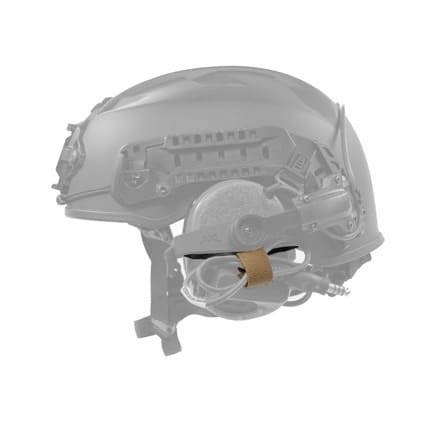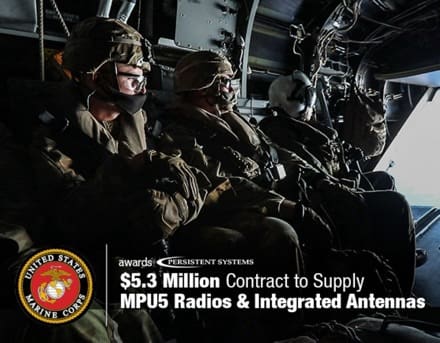Blue Force Gear has just released with our Orange Training Light Refill Packs for their MARCO Marking Light Dispenser.
Get yours here.
Blue Force Gear has just released with our Orange Training Light Refill Packs for their MARCO Marking Light Dispenser.
Get yours here.
New Tactical Power and Data Communication Solution Aims to Extend Equipment Runtime, Lighten Loadouts, and Simplify Comms Kits Reconfiguration.
Washington D.C. (Oct 14, 2024) – OTTO and Freedom Atlantic are proud to announce the commercial launch of WedgeX™, a revolutionary advancement in tactical communication technology. Designed to transform how warfighters manage their comms equipment, WedgeX introduces a new paradigm in the radio power/datawedge market, offering unparalleled adaptability, simplicity, and extended run-time for frontline operators.
As warfare evolves and battlefields become increasingly decentralized and unpredictable, warfighters face the daunting task of manually optimizing their communication kits to meet rapidly changing conditions. Traditional systems require significant time and attention for equipment management, detracting from the critical focus needed for mission success and survival.
WedgeX addresses these challenges by automating and streamlining comms equipment management. Featuring an advanced modular design, WedgeX enables soldiers to quickly reconfigure their kits based on mission requirements, significantly reducing the physical and cognitive load associated with managing multiple devices and adapters.
“WedgeX is a game-changer for the modern warfighter,” said Ken Jillson, Chief Technology Officer at Freedom Atlantic. “From the start, our mission was to create a communications solution that adapts to the soldier—not the other way around. The WedgeX system actively monitors how soldiers use their equipment and intelligently adjusts power distribution to ensure their most critical gear is operational when they need it most. Our goal is to keep warfighters mission-focused, eliminating the distraction of managing their gear.”
The WedgeX system features a suite of game-changing capabilities:
• Automatic Device Run-time Management: Utilizes advanced algorithms to monitor and manage equipment run-time, prioritize critical devices, and conserve battery life with features like power scavenging and temperature-aware charging.
• Multi-Mission Modularity: A flexible design supporting various mission profiles and power needs, from short-term to extended operations.
• Simplicity: Seamlessly integrates data from tactical devices into a unified, configurable data hub and power controller, eliminating the need for extra cables and adapters.
“WedgeX represents a significant leap forward in tactical communication systems,” stated Dan Stanek, President of OTTO. “By offering automatic run-time management and a streamlined configuration process, WedgeX enhances operational efficiency and soldier survivability. It’s designed to meet the evolving demands of modern combat.”
The WedgeX System comprises two primary components: the WedgeX Radio Power Adapter and the SideLink Modular Radio Hub Adapter. The Radio Power Adapter, installed between the radio and battery, supports existing tactical radios with a MIL-STD twist-lock bayonet-style battery interface. The SiswLink connects the WedgeX, radio data interfaces, ATAK EUD, and external data devices, ensuring seamless integration without the need for additional unnecessary external devices.
Co-developed by OTTO and Freedom Atlantic, WedgeX provides warfighters with a comms overmatch by redefining tactical radio power and data distribution. This innovative solution offers rapid adaptability, extended run-time, and lighter loadouts.
Contact OTTO today for more information or a demonstration.
CONSTANT ABLE is one of the most amazing communications accessories I’ve seen in some time. If you’ve ever heard the cliché of “one ring to rule them all” then you understand that ?CONSTANT ABLE is the last PTT you’ll need. It works with everything they’ve thrown at it so far. Just plug and play.
And now, CONSTANT ABLE will be available for pre-order starting this Friday, 10/11. Estimated delivery date is the end of Q4 2024. Pricing starts at $250 and goes to $299 depending on the radio model. Their Goal with the pre-order is to better gauge interest and be prepped to fulfill demand vs selling out right away.
DISXO 32 promises to keep everyone as up to date as possible on the exact delivery date, and if for some reason you pre-order and need to cancel, that option will be available to you.
Go here to turn on email alerts for when CONSTANT is live on the website. More radio models coming soon.
The Individual Signaling Panel (ISP) is GOM’s adaptation of the iconic VS/17 panel, purpose-built for today’s rifleman. Measuring a compact 12×12 inches, the ISP features a high-visibility orange side for signaling and a Multicam side to ensure the user does not inadvertently signal unfriendly forces to their rear.
Get yours at gomdesigns.com.
I get excited when I find out about small businesses with innovative technologies that solve real problems, particularly those owned by fellow veterans. Even better when these capabilities are low cost.
Take for example, MSRS Navigation, which was founded by a retired Tier One operator after having experienced GPS jamming while deployed overseas. In fact, all five of the company’s employees are Veterans and the gear is made in Asheville, NC.
Confronting the Electronic Warfare threat is now a challenge faced by everyone and the Western use of Global Positioning System for navigation can no longer be solely relied upon to accurately determine position and route.

MSRS Navigation has developed the only ITAR-free, Denied-GPS navigation system. What’s more, the system is completely non-RF, with no reliance on satellites or any signals for that matter. There’s nothing to jam.
Having been awarded two patents with three more in process, they instead rely upon an AI/ML engine which examines data and identifies errors from GPS degradation, identifying last known good point to base modeling from. This is supplemented with real-time data from multiple sensors. The result is .1 meter accuracy per mile and is correctable by the end user at any point by simple correction via drag/drop of the icon on the map-based interface GUI, to the correct point. Alternatively, there is a plug-in for ATAK users.
The systems runs independently from, but in parallel with GPS, allowing the user to rely upon GPS in high-fidelity environments. At any point, the user can switch to MSRS if for example, they enter a degraded environment such as jamming or dense foliage or tunnels. MSRS always runs in the background.
The current Army program of record is Mounted Assured Positioning, Navigation and Timing System (MAPS) Gen II which is great if you’re part of the BOIP. If not, MSRS is available today, for immediate deployment. Over forty of their fly away kits (FAK) are currently in use with US and International SOF in overseas combat environments.
Simple to employ, the FAK comes packed in a Pelican 1200 and can be installed in under 30 minutes. Additionally, MSRS is about the quarter of the price of MAPS.
While the system is currently configured for ground and sub-T navigation, the company has a CRADA in place with USSOCOM through SOFWERX to support an upcoming evaluation of the system. To expand its use, they have partnered with Hefring Marine out of Iceland to build a Maritime system and expect to have a working prototype in early 2025.
For more information, visit www.msrsnav.com.
–Eric Graves
AFWERX selects goTenna for a Small Business Innovation Research contract to develop CoTS capabilities to enable communications connectivity solutions for the U.S Air Force.

JERSEY CITY, NJ (September 16, 2024) – goTenna, the world’s leading mobile mesh networking company, was awarded $15M through the Air Force’s Strategic Funding Increase (STRATFI) Program to provide enhanced Commercial Off-The-Shelf (CoTS) mesh capabilities. This award allows goTenna to develop and enhance the company’s already robust ecosystem of integrated, industry-leading CoTS communication equipment that enables connectivity in peacetime and wartime environments. goTenna’s solutions will directly contribute to the Department of the Air Force’s (DAF) Strategic Need for Resilient Information Sharing through hardware and software over mobile ad-hoc mesh networks. goTenna’s technology will increase coordination across all Joint Force assets and partner forces through assured communications and shared situational awareness.
STRATFI is a joint initiative by AFWERX and SpaceWERX designed to assist Small Business Innovation Research (SBIR) and Small Business Technology Transfer (STTR) projects in bridging the challenging gap between development and full production. By providing a multi-year infusion of funds, this effort enables small businesses to attract necessary investors and continue their research and development efforts as they progress towards full-scale capability.
“This contract will enable goTenna to further optimize our commercial off the shelf mesh radio capabilities to better support Air Force and Department of Defense missions,” said goTenna CEO Ari Schuler. “The AFWERX program has been a critical driver for advancing goTenna’s support for the warfighter, and the STRATFI program is ideal for enabling small businesses to successfully transition new capabilities to market. We appreciate the amazing support of our end users in the special warfare community, the Hanscom Air Force base contracting activity, and the STRATFI program office in advancing critical communications capabilities for the US government.”
In addition to the STRATFI contract award, goTenna announced an investment by Vanedge Capital in goTenna’s ongoing Series 1 fundraise. Vanedge is an early-stage venture fund that invests in companies building foundational new technologies with transformational potential, focusing on disruptive hardtech platforms, analytics, and AI.
“goTenna’s resilient mesh networking technology solves vital connectivity challenges for the most demanding customers in the world, and has already proven its worth in critical operations,” said Moe Kermani, Managing Partner at Vanedge Capital. “We’ve been extremely impressed by Ari and the entire goTenna team, and are confident that their relentless focus on their customers’ missions will lead to more growth and greater success.”

The AXL Gen II RAC Link Downlead Retainers attach under the Gen II RAC Link. This allows for a more streamlined method of capturing your headset downlead cables.
Purchased mobile ad hoc networking (MANET) equipment will support U.S. Marine logistics in EUCOM Theater

September 18, 2024 – Persistent Systems, LLC (“Persistent”), a leader in mobile ad hoc networking (MANET), announced today a $5.3 million sale of MPU5 MANET devices, Rugged Display & Controllers (RDCs), and Integrated Sector Antennas to the U.S. Marine Corps in support of the 2nd Marine Logistics Group.
The sale of the MANET equipment, including C-Band and L-Band RF cards, follows a similar acquisition of S-Band RF cards by the Marines in January 2023 to advance their logistics networking capabilities in the EUCOM and CENTCOM regions.
“The Marine Corps is undergoing a force design and modernization effort to deal with near-peer competition,” said Luke Wood, Persistent Systems VP of Business Development, U.S. Navy/Marine Corps. “They are looking into reliable high-bandwidth commercial technologies to solve their operational requirements, and we’re supporting that campaign of learning, both at the headquarters and operating forces level.”
Purchase of the MPU5 provides the Marines with access to the Wave Relay® MANET algorithm for peer-to-peer sharing of voice, video, text, sensor, and GPS data. The MANET provides immediate network access and interoperability with other network-based platforms fielded by the Marine Corps and international partner forces.
All network data stored on the MPU5 is viewable on the RDC for increased situational awareness and command-and-control of unmanned systems. Additionally, rapidly mounted Integrated Sector Antennas (to poles, masts, or towers) extend the range of the MANET “bubble” created by the MPU5s.
“The MANET equipment will go to a few logistics battalions for vehicle-to-vehicle and dismounted security force communications,” said Wood. “The rest will be deployed as needed for advanced expeditionary bases, logistics hubs, and other logistics missions.”
Extended network range will allow Marines to share video more widely from previously disconnected EO/IR video cameras, unmanned aircraft systems, and explosive ordinance disposal robots.
“All this enables the Marines to make sense of the battlefield and coordinate against adversary platforms and formations,” he said.
Persistent will continue to support the service’s manned and unmanned ground combat vehicle efforts, as well as manned and unmanned maritime vessels.